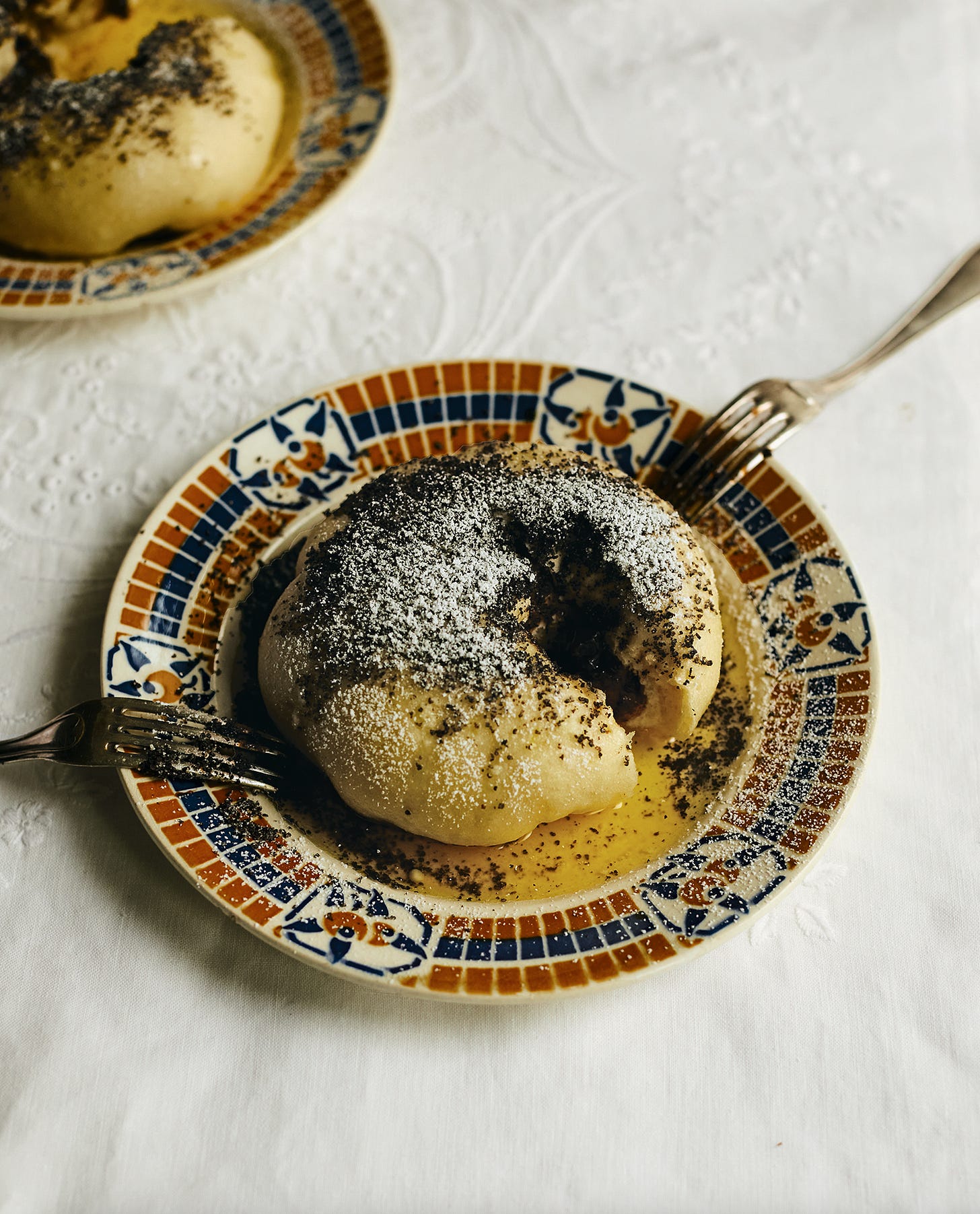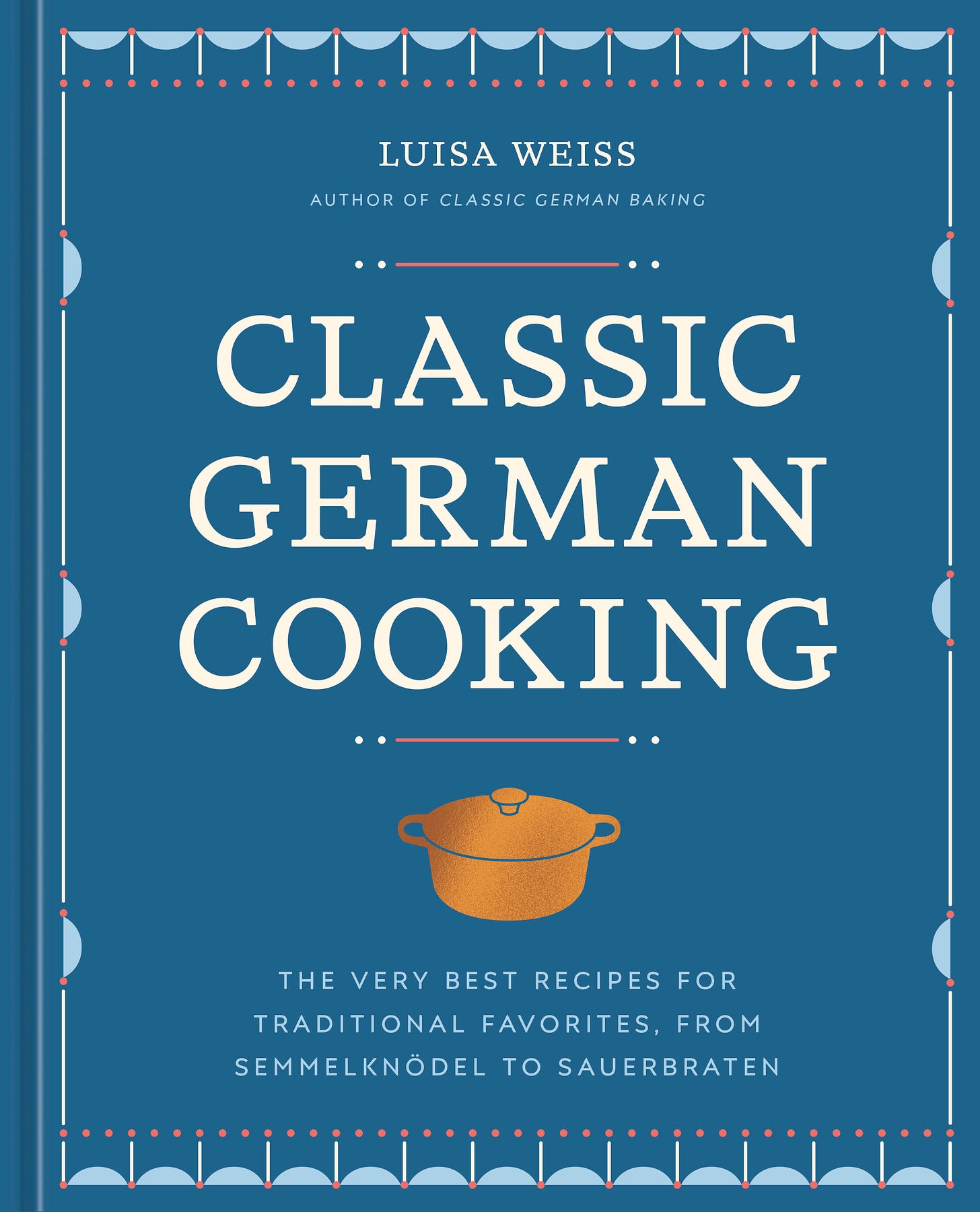GERMAN COMFORT FOOD
Homemade spätzle with mountain cheese and caramelized onions, from Luisa Weiss new book, Classic German Cooking. Comfort food, with a side of European history.
Welcome!! ~ This is a reader supported publication. Upgrade to paid below for full access to recipe archives, complete travel guides, essays and more. ♡ Other ways to support my work? Buy my books and forward this post to a friend.
Hello!
It’s November!! Halloween is behind us (my thoughts on Halloween!), and while I’m still feeling Pumpkin Chocolate Chip Cookies and apple cakes, I feel ready to go deeper with cozy comfort foods, long reads, and meals with what we writers call story.
So this week, I’m writing you with a guest appearance from my friend and beloved food writer
, author of Classic German Cooking, Classic German Baking, and the memoir My Berlin Kitchen, a sensation in the food world back at its publication in 2012, and still a spectacular story of longing and reinvention.I was introduced to Luisa years ago via a mutual friend when we lived in New York City. She edited books and wrote the popular blog Wednesday Chef, and I was a recipe writer at Food Network. Somewhere in between, we both lived in Paris (not at the same time); later, she married a Berliner, and I married a Hungarian.
Luisa lives with her boys (her husband and two sons) in Berlin, a life she shares small peeks into via her Instagram and Substack, Letter from Berlin. It is always a gift when Luisa’s words arrive. In many ways, we are kindred—building a career around books and words, raising children between two cultures, and trying to give our families roots in more than one continent infused with the best of their own parents’ childhoods. But our stories are also different: Despite being American (and Italian!! read the book!), Luisa was born in Berlin and lived there with her mother as a child. Moving there with her husband, Max, 14 years ago was as much a homecoming as an adventure.
Luisa is a scholar as much as she is a writer. Her second book, Classic German Baking, represents decades of research. And her newest book, Classic German Cooking, follows suit—with plenty of history, following threads of recipes and traditions from Germany and its neighboring Austria, Switzerland, and Hungary (in her book, you’ll find Goulash, Liptauer—Austrian seasoned quark spread, and apricot dumplings—all foods beloved by Hungarians, Austrians and Germans alike—each given their own names as they cross border to border).
Luisa’s strong voice, storytelling, and the way she combines history, tradition, and recipes are impressive, but much like the food itself, there’s a comfort to her words. Her writing is unstuffy and candid, warm and welcoming. In the intro to Classic German Cooking, Luisa writes:
“It’s easy to poke fun at German food, which is riddled with clichés and lives up to quite a few of them. Many Germans have an inferiority complex about their traditional recipes, especially in comparison to their neighbors to the west and south. And yet, to so many, German food is also the purest kind of comfort food. It is simple and hearty, the kind of cooking one turns to in the depths of winter to warm the very soul, the type of cooking that might not ever win a beauty award but will more than make up for it in terms of its power to nourish and comfort.”
There are a lot of recipes we could glean from Classic German Cooking. If you, like me (and more than 40 million Americans!), have German roots (my family is from Northern Germany), you might find many recipes familiar. Andras's family is also of Swabian descent (the German-Hungarian village our home is in, where we spend summer months, is still a dual-language village today). And since Germany, Austria, and Hungary share much history, the goulash (above) and paprika stews, Kaiserschmarrn (Emperor’s Crumbs), and giant steamed dumplings with plum butter and poppy seeds (below, which Austrians and Germans call Germknödel) found in the book are my husband’s childhood favorites, too.
You’ll also find simple classics, foods that might already be a part of your family table. As Luisa points out: “German food is also American food. From Texas to Minnesota, from Pennsylvania to Washington, many Americans hold a special place in their hearts for traditional German foods such as Sauerbraten, potato salad, thick pea stews, and sausages of all kinds. German food is also Jewish food; what are matzo balls if not Knödel, latkes if not Kartoffelpuffer?” You’ll find all those recipes here, too.
The recipe that called me in most today to share with you is Käsespätzle—the German equivalent of mac and cheese, and the very definition of comfort food. Years ago, I had a Swiss roommate, and she made something similar for me during many long, cold, damp months when we were living in Ireland. I loved the earthy onions, the salty cheese, and the soothing soft noodles. This is the kind of food you’d want to eat on Halloween night if you were raising German-American children like Luisa (she often brings her boys from Berlin to Boston, where she also grew up, for trick-or-treat), a recipe you’ll want to hang onto for ski season, for long winter months, when you need something simple and filling at 5 PM before the sky is inky and cold.
If all this leaves you pining for more, you will love Luisa’s books (both are on discount at the links below). Start slow; take your time. Begin with the recipe for käsespätzle, which you’ll find below. I’ll return in a few days with a sweet recipe from Classic German Baking and a deep-dive Q+A with Luisa for paid subscribers.
LIVE: Luisa and I will be cooking together LIVE on Instagram, next Tuesday, November 5, 2024, around 10 AM. It’s election day! Get out there and vote, then tune in and cook this recipe along with us. (Use the recipe below to have the ingredients handy in advance). We’d love to see you there.
xx
Sarah
Käsespätzle
SWABIAN NOODLES WITH MOUNTAIN CHEESE AND CARAMELIZED ONIONS.
Excerpted from Classic German Cooking by Luisa Weiss (Ten Speed Press).
Spätzle are Germany’s most famous noodles. Swabia, a region in Germany’s prosperous southwest, has long laid claim to them, though they are made widely throughout southern Germany and neighboring Austria and Switzerland. In fact, there are paintings dating to the Middle Ages that depict people holding the board traditionally used to make Spätzle, though their provenance beyond that point is unknown.
Spätzle show up in a variety of different ways on German tables. They are a frequent side dish to Germany’s many roasts, often swimming in a pool of rich brown gravy. One beloved Swabian dish pairs Spätzle with lentil stew and boiled sausages; another has them float in a savory beef broth with cubed potatoes and shreds of soup meat (Gaisburger Marsch). They can be made verdant with the addition of boiled, pureed spinach or chopped fresh herbs to the batter. Spätzle can even show up as dessert or nursery food, lightly sweetened and served with confectioners’ sugar and ground poppyseeds or applesauce. But, arguably, their most beloved role is as the anchor of this popular dish in which freshly boiled Spätzle are layered with redolent heaps of grated mountain cheese, then topped with a panful of caramelized onions. Chewy, cheesy, savory, and endlessly comforting, Käsespätzle are Germany’s version of mac and cheese.
Spätzle batter is simple, made of just flour, eggs and milk or water, plain or sparkling, which is supposed to help achieve a light and chewy texture of the noodles.
Then, the batter, which is quite sticky, is either smeared on a board and scraped into boiling water with a knife or bench scraper or poured or pressed through a special Spätzle press or sieve. Spätzle were traditionally made with spelt flour, but today many use wheat flour. They’re quite robust and can be cooked in advance (if making in advance, rinse the just-cooked noodles with water, cool completely, then store in the refrigerator for a few days). This recipe serves four but is easily scaled up or down. The rule of thumb when making Spätzle is to calculate about ½ cup plus 2 Tbsp / 100g of flour and one egg per person.
SERVES 4
2½ cups / 400g all-purpose flour
3 tsp salt
4 eggs
About 1 cup / 250ml club soda
2 Tbsp unsalted butter, plus more for the serving dish
2 medium yellow onions, cut into thin half-moons
2.6 oz / 75g Alpine cheese*, grated
First, make the Spätzle batter: Place the flour and 2 tsp of salt in a large bowl. Crack in the eggs and beat briefly with a wooden spoon, then pour in half of the club soda. Stir vigorously, then add the remaining club soda a bit at a time until the batter is smooth and falls off the spoon in sheets. Cover the bowl and set aside for 30 minutes.
Meanwhile, make the onions: Melt the butter in a medium sauté pan. Place the onions in the pan and sprinkle with the remaining 1 tsp of salt. Cook over medium-low heat, stirring frequently, until the onions are well-browned and fragrant, about 20 minutes. (Depending on your stove, this may take a little longer, up to 35 minutes.) Set aside.
Bring a large pot of salted water to a boil. Butter the bottom of a serving dish or bowl and set aside.
Scrape a ladleful of batter onto a small wooden cutting board without a lip. Hold the cutting board at a slight angle over the pot of boiling water and, using a sharp bench scraper or a knife dipped in water, shave o¨ very thin ribbons (about Å inch / 3mm thick) of batter directly over the pot so that the noodles fall into the water. When they rise to the surface, which will only take a moment, scoop them out with a spider, let the excess water drain, and place them in the buttered dish. Top with a sprinkling of cheese. Repeat with the remaining batter and cheese, working in batches.
When the Spätzle are finished and topped with a final layer of cheese, add the browned onions to the Spätzle and toss until well-combined. Serve immediately.
*A NOTE ABOUT ALPINE CHEESE (from Luisa):
In German-speaking countries, the traditional cheese for Käsespätzle is Bergkäse, or mountain cheese, meaning it is either made in the Alps or from milk from Alpine cows. You can use Gruyère, Appenzeller, and Emmentaler, either on their own or mixed. If you have access to a good-quality cheese shop, you may be able to find Allgäuer Bergkäse, a raw milk mountain cheese from the Allgäu region.
“Classic German Cooking” Copyright © 2024 by Luisa Weiss. Photographs © 2024 by Elena Heatherwick. Published by Ten Speed Press, an imprint of Crown Publishing Group.”









I'm so excited about this book!! Beautiful post :)
This sounds so comforting and cozy! I’ve added the cookbook to my list of must buys!